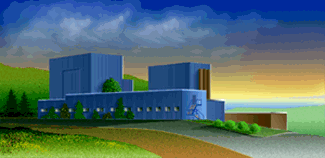

Since the start of this decade, the National Center for Electron Microscopy has experienced the same funding crunch as most other research facilities. New director Dahmen has been working to reverse this trend and is beginning to see his efforts pay off. Plans are now underway for NCEM to acquire four new microscopes plus support laboratories. By the year 2000, when all is in place, NCEM will have returned to worldwide pre-eminence.

The NCEM building will have expanded laboratory facilities which are scheduled for completion in Spring of 1996.
The first of these microscopes, which is expected to be operating within the next two years, is the One Angstrom Microscope. As the name states, this device will resolve images to a single angstrom, using an electron beam at an energy of only 300 kV and a unique image processing process developed at NCEM (LBL patent application IB-859). The reduction in energy from that of the ARM and the HVEM greatly reduces the radiation damage to the specimen without requiring much of a sacrifice in penetration ability thanks to improved sample preparation techniques.
"The One-Angstrom Microscope will be used as a tool for discovery and as a tool for measurement and characterization,"says Dahmen.
The second of the new additions planned for NCEM is a Magnetic Materials Microscope, an electron microscope with a "field-free" objective lens. The electromagnetic lenses used in electron microscopes can present a major problem when the sample being imaged is itself magnetic.
"It is like shining a flashlight onto a piece of photographic film," explains Dahmen. "You wipe out the magnetic field of the sample."
With the Magnetic Materials Microscope, the electromagnetic objective lens is split in half. The magnetic fields of each lens half flow in opposite directions. This leaves the magnetic field of a sample untouched when it is sandwiched in between the two halves.
"With this technique we can obtain nanometer scale resolution of magnetic materials and study the interplay between magnetism and structural defects," says Dahmen. "This interplay is the key to developing new magnetic materials. No other facility in the world can offer this capability."

An illustration of the series reconstruction method for high resolution imaging. Shown here with computer-simulated images is the NCEM-invented extended-resolution electron microscopy (EREM) technique. This and similar techniques provide a method of building up a single high-resolution image from several (the illustration shows six) images containing different spatial frequencies.
NCEM's other two new microscopes will get their own three-story building, adjacent to the existing complex. Called the Electron Beam Microcharacterization Facility, this building will house a 400 kV transmission electron microscope (TEM) and a "Z-contrast" scanning transmission electron microscope (STEM). In combination with NCEM's other microscopes, these new instruments will enable researchers to fully investigate the relationship between the microstructures of solid materials and their physical properties under a broad range of external conditions.
The 400 kV TEM is designed for researchers to do materials science experiments within the microscope's vacuum chamber. It will be equipped with a high-speed video camera that can record transformations, deformations, and chemical reactions, plus special observation stages that allow materials to be subjected to extreme conditions of temperature, pressure, or electrical fields. An associated state-of-the-art specimen preparation facility can be used to "write," or carve, nano-sized (billionth of a meter) features into samples for the study of friction, fatigue, wear, or electrochemical behavior.
"With the 400 kV microscope, instead of looking at static structures, we can design samples for dynamic reactions, such as electrochromic switching the color change in a transparent material when a current is applied and watch what happens as it takes place," says Dahmen. "We can then take thin slices of the sample and use the more powerful microscopes for detailed post-mortem studies."
The Z-contrast STEM provides a stylus-like beam that penetrates the surface of a sample, scattering electrons off its crystalline web. These scattered electrons yield information that can be used to provide spectroscopic pictures about the sample's chemistry on a nanometer scale and about its structure on a near-atomic scale. Focusing down to a 1.3 angstrom spot size, the new STEM's detector collects electrons scattered near the sample's nuclei. This high angle scattering roughly distinguishes different elements by their mass. Knowing which types of atoms make up a sample, scientists can then use the One-Angstrom Microscope to see exactly how these are atoms arranged.
Designated by the Department of Energy as a national user facility, NCEM will continue to be open to all qualified researchers. Providing even greater access to NCEM's expanded facilities and making these facilities even more user-friendly is one of Dahmen's top priorities. He shares the view once expressed by his predecessor, Gareth Thomas, that: "Materials science and engineering cannot progress without the electron microscope."
NCEM's tenth birthday was a happy one. But, as the poet Robert Browning once said, the best is yet to be.
Return to LBL Research Review Table of Contents